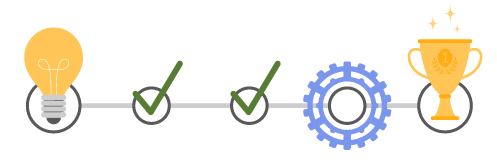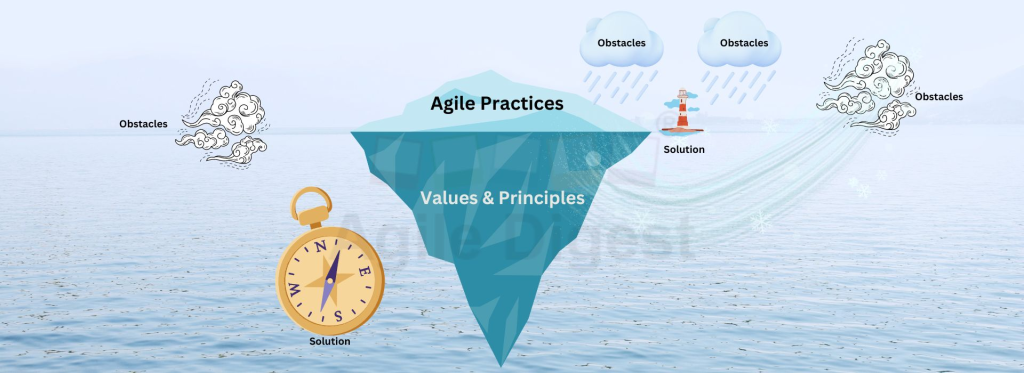PILOT AGILE Transformation
Kickstart your Agile journey with our Pilot Agile program. This approach allows your organization to experience and understand Agile by implementing it within a single team or a small group of teams, thereby minimizing risks.
Strategy
Our strategy includes intensive Agile training and workshops, followed by consistent coaching. We encourage teams to have regular retrospectives to evaluate what’s working and what needs improvements.
At Agile Digest we believe in creating custom Agile transformation journeys that cater to your unique business needs. As each organization is different, so too should be its approach to Agile transformation. It’s not a one-size-fits-all scenario. That’s why we take the time to understand your specific needs, challenges, and objectives before crafting a tailored Agile transformation plan for you.
Whether you are starting small with a Pilot Agile, scaling up with Scaled Agile, or are ready for a complete overhaul with Enterprise Agile, we are equipped with the expertise and experience to guide you every step of the way. We’re more than just consultants – we’re partners invested in your success.
Don’t let the complexities of Agile transformation intimidate you. With the right guidance and support, you can navigate this journey confidently. We are here to support you, empower you, and work alongside you to achieve your business goals.
Get in touch with us today to find out how we can tailor an Agile transformation journey that will drive your organization to new heights of productivity, efficiency, and customer satisfaction. We look forward to embarking on this exciting journey together.
Understanding Pilot Agile
Your First Step Towards Agile Transformation
Pilot Agile is an approach to Agile transformation that involves implementing Agile practices within a single team or a small subset of teams before adopting it across the organization. It provides an opportunity to experiment with Agile methodologies, principles, and practices in a controlled and manageable environment.
Opting for Pilot Agile allows an organization to test the waters, understand the intricacies of Agile, and gauge how well it aligns with the company’s existing culture and workflow. By starting small, the organization can learn valuable lessons, identify potential challenges, and develop effective strategies without disrupting the entire operation.
This approach is particularly advantageous for organizations that are new to Agile. It reduces the initial risk associated with a full-scale transformation and offers a chance to witness the tangible benefits of Agile firsthand. By seeing the positive impact on a smaller scale – such as increased team collaboration, improved product quality, and faster delivery times – stakeholders can build confidence in the Agile approach.
Moreover, Pilot Agile creates Agile champions within your organization. The teams involved in the pilot phase become knowledgeable in Agile practices and can later help to drive the Agile transformation on a larger scale.
In essence, Pilot Agile acts as a stepping stone towards a broader Agile transformation, enabling organizations to understand, learn, and adapt to Agile in a low-risk setting before committing to a larger, organization-wide change.


Training The Foundation of Successful Pilot Agile Transformation
It also addresses key Agile concepts such as self-organization, cross-functionality, continuous improvement, and delivering value incrementally.
Training also serves as a platform for team members to discuss and address any apprehensions or misconceptions about Agile. It can encourage teams to actively participate in the transformation process, ask questions, and raise concerns.
Furthermore, training paves the way for consistency in Agile practices across the team. When everyone has the same level of understanding and follows the same practices, it enhances collaboration, reduces confusion, and facilitates a smoother transition.
In the Pilot Agile approach, the trained team serves as a beacon for the rest of the organization. They become the Agile champions, setting a precedent and sharing their learning experiences with others.
Therefore, training forms the bedrock of the Pilot Agile transformation, providing the team with the knowledge, skills, and confidence they need to navigate the Agile journey successfully. It’s not just about doing Agile—it’s about being Agile.
Our Approach to Pilot Agile Implementation Roadmap
Implementing Pilot Agile is a structured process that involves careful planning, execution, and evaluation. Here's a step-by-step guide that outlines this journey:
Our goal of Pilot Agile is not just to implement a new process, but to instill a new way of thinking and working – one that is more collaborative, adaptable, and customer-focused. Every step in this guide is geared towards achieving that goal.
Choosing The Right Team
The success of a Pilot Agile implementation can largely depend on the selection of the right team or teams. This is a critical step, as the chosen team will be the first to adopt and champion the new Agile ways of working within the organization. Here are some key aspects we consider choosing the right team

Openness
We prioritize teams that demonstrate openness to new ideas and methods. A culture of open communication and transparency is essential, as it fosters a collaborative environment where every team member feels valued and empowered to share their insights and concerns.
Cross Functional
Selecting teams that are cross-functional ensures that all necessary skills are represented, allowing for self-sufficiency. This diversity in skill sets not only speeds up the development process but also enhances problem-solving capabilities, as team members can view challenges from various perspectives.
Relevant
The team chosen must have relevant experience and knowledge related to the project’s core areas. This ensures that the team is not only familiar with the specific industry and technology but also understands the customer’s needs and expectations, leading to more effective and targeted solutions.
Supportive Leadership
Leadership within the team must be supportive and committed to Agile principles. Leaders should act as facilitators, encouraging team autonomy and rapid decision-making, rather than micromanaging. This empowers the team to adapt quickly to changes and take ownership of their work.
Team Size
We recommend small to medium-sized teams, typically 5-9 members. This size is optimal for maintaining high levels of collaboration and communication, crucial aspects of Agile methodologies. Smaller teams are more agile and can adjust more rapidly to project shifts.
Willingness To Learn
The ideal team is not just skilled but also eager to learn and grow. Continuous learning is crucial in Agile environments as it drives improvement and innovation. We look for teams that are enthusiastic about adopting new tools, techniques, and approaches to enhance their work and outcomes.
Creating The Pilot Agile Plan,
Preparing a robust plan for a Pilot Agile implementation requires thoughtful consideration of several aspects. Here's how we go about it:

The Pilot Agile implementation plan should not be overly rigid. One of our key tenets of Agile is embracing change, so we prepare to adapt the plan as we learn more about what works best for your team and organization.
Navigating Challenges In Agile Transformation
The objective of Agile transformation is to foster a culture of flexibility, continuous learning, and improvement. Facing and overcoming these challenges is part of the journey towards becoming a truly Agile organization.

Resistance To Change
Change Can be Upsetting and there might be resistance from Team members to the traditional way of working To handle this ensure open communication about the benefits and reasons for the change. Engage resistant members in the process and address their concerns sincerely.
Insufficient Training
Without adequate training. The Agile implementation could lack depth and might not bring about the desired changes. Invest in comprehensive training covering Agile principles, practices, roles, and necessary mindset shift .
Lack Of Leadership Support
Agile Transformation requires buy-in and support from all the level of the organization, especially from the leadership to multiple this leadership, to mitigate this, leadership should be involved from the beginning and show how Agile can bring about improved result.
Inconsistent Implementation
Agile can be differently across the team, causing inconsistency and confusion .to avoid this, establish clear guidelines and ensure all teams members receive the same level of training.
Neglecting Agile Values And Principles
Here can be a tendency to focus on practices and ceremonies, neglecting the core values and principles of Agile. To address this, emphasize the Agile mindset and values from the beginning and throughout the transformation . .
Impatience For Results
Agile Transformation is a journey, not a quick fix. There might be pressure to show immediate results. but it's important to manage expectations and communication that benefits will be seen over time
Lack of Feedback Loop
Not having a mechanism for regular feedback and adaptation could hinder improvement. To counter this, implement ,regular retrospectives to reflect on what's working and what's not, and to adjust accordingly.
Insufficient Training
Without adequate training. The Agile implementation could lack depth and might not bring about the desired changes. Invest in comprehensive training covering Agile principles, practices, roles, and necessary mindset shift .
Lack Of Leadership Support
Agile Transformation requires buy-in and support from all the level of the organization, especially from the leadership to multiple this leadership, to mitigate this, leadership should be involved from the beginning and show how Agile can bring about improved result.
Transform Your Organization with Agile
Let's Make It Happen
Together.
Navigating the complexities of Agile transformation can be challenging, but you don’t have to do it alone. Our team of experts is ready to guide you through every step, ensuring a seamless transition that unlocks your organization’s full potential. By embracing Agile, you’re not just adopting a new methodology—you’re setting the stage for unparalleled innovation, efficiency, and employee satisfaction.

